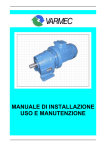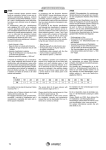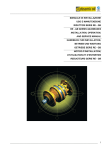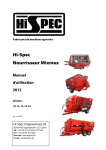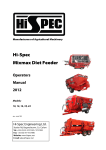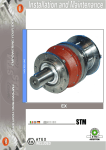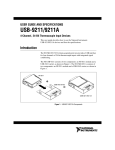Download VARMEC - Installation, Operating and Maintenance Manual
Transcript
INSTALLATION, OPERATING AND MAINTENANCE MANUAL TABLE OF CONTENTS - GENERAL SAFETY INFORMATION……………... …..………………………..pag. 2 - INDENTIFICATION PLATE.….……………….………………….………………pag. 4 - TECHNICAL INFORMATION………………………………...……….…………pag. 5 - STORAGE ……………………………………..……………….………………….pag. 5 - INSTALLATION .……………………………..…………………..………………..pag. 6 - INSTALLING THE MOTOR......... ………………………………..………………pag. 7 - SET UP………….. ………….....………………………………….……………….pag. 7 - MAINTENANCE ……….……………………….…………………..……………...pag. 8 - LUBRICATION ….……………………………….…………………..…………….pag. 9 - MALFUNCTIONS: CAUSES AND REMEDIES…...……………..………………….……………………..…………...pag. 10 Ed. 07/2004 Rev.1 1 GENERAL SAFETY INFORMATION THE PURPOSE OF THIS MANUAL This manual has been produced by the manufacturer in order to provide authorised personnel in relation to the reducer, with all the necessary information about transport, movement, installation, maintenance, repairs and warehouse storage. VARMEC s.r.l. reserves the right to make changes, adaptations or improvements to this manual and this does not constitute motives for believing the present manual to be inadequate. • • Indications given in correspondence with this symbol, and highlighted by a border, are of exclusive referral to machinery that conforms to the ATEX Directive 94/9/EC (products designed for use in potentially explosive atmospheres). The manual drawn up for the ATEX directive is an integral part of the instruction and maintenance manual. MANUFACTURER’S LIABILITY The manufacturer declines all liability in the following cases: • Use of the reducer contrary to national health and safety laws. • Incorrect installation, none or incorrect following of the instructions given in this manual. • Faults in the electric power supply (for motor-reducers). • Modifying or tampering • Operations carried out by non-qualified or unfit personnel The safety of the reducer also depends on the scrupulous observation of information given in this manual – which must be read carefully before installing, starting up or carrying out any maintenance on the reducer. Please read all usage and maintenance instructions and comply with all precautions – in particular you must: • • • • Always operate within the usage limits of the reducer. Always carry out a diligent general maintenance. Inspections and maintenance must only be performed by trained personnel. Use only original spare parts and use lubricating oils that have been recommended by the manufacturer. ATTENTION! The configurations given in the reducer’s catalogue are the only ones allowed so DO NOT attempt to use the same reducer in disagreement with the indications supplied. The instructions given in this manual do not substitute but summarise the obligations of existing legislation on safety norms. Ed. 07/2004 Rev.1 2 • • • • • For use conforming to the classification according to the ATEX Directive 94/9/EC, please respect the technical data indicated on the identification plate and the documentation which must be placed near the machine. All procedures pertaining to transport, storage, maintenance, start up etc. must be carried out by specialised personnel and in the complete absence of potentially explosive atmospheres. There must be NO power supply to the reducer and the last must not be functioning. Caution must be taken that it cannot be accidentally switched on and that none of its parts can accidentally move or rotate. The Varmec reducer is made for use in potentially explosive environments due to the presence of gas and air mixtures or air and fine dust mixtures. The reducer belonging to group II and category 2 can be used in zones 1, 21, 2 e 22, places in which a potentially explosive atmosphere can occasionally form during use in the shape of a gas or dust cloud/mist. Use the reducer togheter with other devices only if these can be operated in the same zones. The characteristics of the explosive mixtures must respect the max temperature information given on the identification plate. If the reducer is to be used in potentially explosive atmospheres caused by air/dust mixtures, the minimum temperature of ignition/explosion of the fine dust cloud must be superior to the value given on the identification plate, multiplied by a coefficient of 1.5 to which is then added 75K if a layer of dust less than 5mm is presumable. Ed. 07/2004 Rev.1 3 IDENTIFICATION PLATE Each reducer is fitted with an identification plate that shows the principal technical informations concerning the functional and construction characteristics. All information found on the identification plate must be specified on any spare parts order. Type : Identification of the reducer THIENE (VI) ITALY Date : Month /year of production Type i : Transmission ratio i Date SYNT HET I C O I L I SO VG 320 Type : Identification of the reducer THIENE (VI) ITALY Type Mn2 max. Mount. Pos. Nm Date Mn2 max. : Torque Mount. Pos. : mounting position Date : Month/year of production rpm Tech. file N° II 2G c k i : Transmission ratio Code : Product code i Code n1 max. CE X II 2D c k n1 max. : max entrance revs °CX Tech. file N° : technical file deposit number SYNT HET I C O I L I SO VG 320 Atex Markings II : Group 2 : Category (2G for gas and/or 2D for dust) G : Use in explosive atmosphere, presence of gas/air mixtures, vapours or mists D : Use in explosive atmosphere, presence of dust/air mixtures c : Protection with construction measures k : Protection by immersion in liquids Max surface temp. C°: Temperature class for 2G and grade values for 2D X : observe operating and general documentation for safe use in potentially explosive atmospheres. Ed. 07/2004 Rev.1 4 TECHNICAL INFORMATION VARMEC speed reducers and motor-reducers have been designed and manufactured to be fitted on finished machines or systems and are normally used in industrial, mechanical, chemical, agricultural-food or building industries etc. Please consult the corresponding sales catalogue to obtain all technical and descriptive information. During the design of the reducers, all essential safety requisites applicable by the Machines Directive 98/37/EC have been taken into consideration. Electric motors supplied by VARMEC conform to the Low Tension Directive 79/23/EC and to the Electromagnetic Compatibility Directive (EMC) 89/336/EC. TECHNICAL SPECIFICATIONS ADOPTED FOR REDUCERS IN ATEX EXECUTIONS • • • • • • Use Only synthetic lubricants. Oil seal in Viton Blockage of all external screws with a sealant Breather with anti-intrusion vent valve Fitted with oil inspection plugs for all reducers Input speed to the reducer must not exceed n1= 1500 rpm STORAGE For a correct storage of the reducers, we suggest the following: • • • • • • • • • Avoid open-air areas, areas open to bad weather conditions or with excessive humidity levels. The environment must be sufficiently clean and without excessive vibrations to avoid damaging the bearings (this caution should also be followed during transport). Always provide a layer of insulation between the reducer and the floor to prevent direct contact. Place the reducer on a stable base and make sure that there is no risk of impromptu dislodging. Rotate the shafts by a few turns every six months to prevent bearing and oil seal damage. For storage periods longer than 60 days, all coupling surfaces should be protected with antioxidising products. For storage periods of over 6 months, all external machined and coupling parts of the reducer should be greased to avoid oxidisation. Also, reducers supplied without lubricant, should be filled with oil, placing the vent valve in the highest position and before use filled with the correct quantity and type of suggested lubricant. Reducers must not be stored in potentially explosive atmospheres Before using the reducer, all external parts must be accurately cleaned with a solvent to remove the anti-oxidising products. ATTENTION! Solvents must not come into contact with the oil seals in order to avoid damaging them. Carry out this procedure away from potentially explosive atmospheres. Ed. 07/2004 Rev.1 5 INSTALLATION It is highly suggested to follow the indications stated below regarding the installation of the reducer: • • • • • • • • • • • • • • • • • • • Verify that nothing was damaged during transport or storage. Accurately clean the reducer, remove any packaging or protective residual product. Verify that the information given on the identification plate corresponds to that specified on the order. Check that the machine structure on which the reducer is to be installed is sufficiently rigid and robust enough to support his weight and the forces generated when working. Make sure that the machine is switched off and that it can’t be accidentally turned on. The fixing to the machine must be stable to avoid any kind of vibrations; verify that the coupling surfaces are flat and very clean. Before assembly, lubricate the contact surfaces in order to avoid gripping or oxidisation. Insure that there is a correct alignment between the motor and the reducer – and between the reducer and the operating machinery. Parts that will be coupled with the output shaft of the reducer must be machined with ISO tolerance H7 to avoid couplings too much tight that could damage the reducer. For the assembly and disassembly of such parts the use of adequate pulleys and extractors is advisable making use of the apposite threaded hole found at the head of the extremity of the output shaft. To avoid damaging the shafts or the reducer supports do not use hammers or other improper instruments Coupling with the follow input shaft of the gearbox must be done with shafts with tolerance ISO h6; assembly should in any case be done without forcing any parts. For reducers with oil level plug, make sure that this conforms to the assembly position of the reducer. For reducers supplied complete with oil, after installation, switch the blind plug used for transport with the breather vent plug supplied by the manufacturer. To fill up or top up with oil, always make sure the oil level reaches the half way of the oil level plug. Reducers already fitted with oil bath do not necessitate this procedure. Verify that the power supply voltage values printed on the identification plate of the electric motor coincide with the mains power supply. Paint or varnish should never go on machined surfaces, oil seal, holes of the breather vents (if present), and the identification plate. If knocks, bangs and overloads are expected during functioning then safety motors, torque limiters and safety joints etc. must be used. In case of ambient temperatures not included between –15°C e +50 °C, contact our technical service. All installation procedures must be carried out in the absence of a potentially explosive atmosphere. The atmosphere of use must respect the indications of superficial max temperature found on the identification plate according to the ATEX norms. Predispose opportune protections to prevent dangerous build ups of dust – liquids near the seals and the protruding shafts. As a safety measure against ‘unscrewing’, apply a sealing liquid to the threads of all screws used to fix the reducer to the structure or to the electric motor. For correct use in explosive atmospheres together with other devices (like an electric motor) insure that these also conform to ATEX at least belonging to the same category of the reducer (see identification plate). Ed. 07/2004 Rev.1 6 • Insure that the applied load does not exceed the values for which the reducer is destined. INSTALLING THE ELECTRIC MOTOR To assembly the electric motor to the reducer it is advisable to respect the following indications. • • • • • • • To facilitate assembly, lubricate the electric motor’s shaft with a synthetic grease. Do not force the coupling and don’t hasten or prompt with the use of improper instruments (hammers, screwdrivers etc.) Avoid damaging the coupling surfaces with too high axial and radial loads. Tight all the motor fixing screws. Make sure that the electric motor is ATEX certified in at least the same category as the reducer (see identification plate). Place a layer of sealant (Loctite 574) on the coupling surfaces of the flange of the electric motor. Also seal the conjunction zone between the reducer and the motor and close any eventual cavities found between the surfaces of the flanges. START UP Carry out a general check before starting the reducer to insure that all norms given in the installation paragraph have been respected. In particular please check the following: • • • • That the assembly position of the reducer is the correct one and matches that given on the identification plate. That the oil level is correct and that there are no leaks from the plugs or gaskets That the power voltage of the electric motor corresponds to that expected That there are no abnormal or unusual noises or vibrations Shut down the reducer if you encounter any abnormal functions and contact out technical office. Before start up, verify the following: • • • The ATEX conformity of every accessory or device connected to the reducer The compatibility of the atmosphere of the place in which the reducer is to be used with the indications given on the identification plate. The max temperature of the surfaces of the reducer must not exceed the value indicated on the identification plate ATTENTION! The Max surface temperature is reached after 3 – 4 hours of running at full load. • Once the installation is over, clean the reducer making sure that there are no dust deposits exceeding a depth of 5 mm. Ed. 07/2004 Rev.1 7 MAINTENANCE • • • • • • • • Before proceeding with any kind of maintenance, check that the power supply to the reducer is turned off, that it is not in service and then activate all safety devices. Only use original spare parts – refer to indications given in the spare parts catalogue for that particular reducer. Use Loctite 574 as a surface sealant. Periodically check the external cleanliness of the groups, particularly in areas greatly concerning the cooling system. Periodically check for any oil leaks and especially around the oil seals. If and when an oil seal needs to be changed, apply a layer of synthetic grease SHELL ALVANIA EP (LF)2 to the oil seal lip before proceeding with assembly. Use synthetic lubricant oil ISO VG 320; check that the breather in the vent is clean and using the opportune oil level plug periodically check the correct quantity of oil in the correct assembly position. If it is necessary to fill or top up the oil, use the same oil brand or use one that is compatible with that already present in the reducer. When compatibility between oil brands doesn’t exist or is doubtful, it is advisable to completely empty the oil from the reducer and wash it out to remove any residue before proceeding to fill with new oil. With reducers that are lubricated for life it is not normally necessary to periodically substitute the lubricant. Used and substituted lubricant must be disposed of according to the legislation in vigour concerning the disposal of pollutant liquids. In relation to the reached temperatures of the lubricant, oil changes should be carried out at approximately the intervals indicated in the table found below: • • • • Oil temperature (°C) Oil change interval (h) < 60 25000 60 - 80 15000 80 - 95 12500 All maintenance must be carried out in the absence of potentially explosive atmospheres. Before each usage check the oil level by using the opportune oil level plug. Check for the presence of any oil leaks on the transmission shafts and check the state of the seals. If any oil leaks are found, check the presence of lubricant inside the reducer and contact our technicians or substitute the seal. After switching on, make sure that there are no noises or vibrations which indicate wear and tear of the bearings. Accurately clean the outside of the reducer to avoid an accumulation of dust deposits that surpass 5mm. Ed. 07/2004 Rev.1 8 LUBRICATION All Varmec reducers and motor reducers are filled with synthetic oil lubricant Shell Tivella Oil SC 320. Based on size, the reducer can be supplied complete with oil or without. It is the customer’s responsibility to insert the correct quantity of oil into reducers not already supplied with oil before ‘start up’. The quantity of lubricant to be inserted and the type of reducer – with or without oil, are tabled in the corresponding sales catalogue. Respect all the indications for installation, start up and maintenance. If not correctly applied, oil leaks or insufficient lubrication could occur resulting in a danger of explosion. RECOMMENDED OIL TABLE BRAND Ed. 07/2004 Rev.1 TYPE OF LUBRICANT SHELL Tivela Oil SC 320 AGIP Telium VSF 320 ESSO Spartan EP 320 KLÜBER Klübersynth GH 6 320 MOBIL Glygoyle HE 320 CASTROL Alphasyn PG 320 TOTAL Carter SY 320 TEXACO Synlube CLP 320 FUCHS Renoling PG 320 9 MALFUNCTIONS: CAUSES AND REMEDIES MALFUNCTION Excessive tempertaure (of regime or bearings) Unusual running noises Oil escaping from oil seals POSSIBLE CAUSES Inadequate lubrication: -excessive or insufficient quantities of oil - unsuitable lubricant (typology, too viscose, worn out, etc.) - conical roller bearings registered too tightly - excessive ambient temperature Air openings of an obstructed fan cover Damaged or defective bearings or not well oiled Tooth wheel damage REMEDY Check: - oil level (when reducer is still) - the type and/or state of lubricant Contact VARMEC srl Increase the cooling or change the ambient temperature Clean the fan-cover Contact VARMEC srl Contact VARMEC srl Damaged or defective bearings or not well oiled Conical roller bearings with excessive clearance Vibrations Oil seal with worn or damaged oil seal lip or incorrect assembly Damaged rotating seat (lined, rusty, marked etc.) Constructive positioning differing to that written on identification plate Contact VARMEC srl Contact VARMEC srl Check fixings Substitute the oil seal Rigenerate the seat Correctly orientate the reducer WARNING: SHUT DOWN THE REDUCER IMMEDIATELY SHOULD ANY OF THE ABOVE FAULTS OCCUR! NOTE When contacting VARMEC srl, please indicate the following: • • • All information found on the identification plate of the reducer or the motor-reducer The nature and time length of the damage When and in what conditions the damage occurred Ed. 07/2004 Rev.1 10 Ed. 07/2004 Rev.1 11












